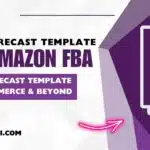What you’ll learn
Want to know how to sell to Amazon directly? Read on.
You know all about the advantages of selling through the Amazon platform. That being said, selling directly to them isn’t exactly easy. Their strict Vendor Terms and Conditions make it quite challenging for businesses to get approved.
Note: Check out our guide on Amazon restocking fees.
Most brands who apply are rejected at first and have to rework their brand identity before they can even be considered as vendors.
Whether you’re just thinking about selling to Amazon directly or are currently in the process of doing so, this article will help you with Amazon information, their vendor policies and what it takes to sell your products on their website.

How to Sell to Amazon Directly – What You Should Know
Before you dive into the logistics of selling on Amazon, it’s important to understand the basic concept.
If you become a vendor for Amazon, meaning they buy from you at wholesale, you have to follow Amazon’s Vendor Terms and Conditions (VTC). You risk getting your Amazon seller account suspended or even banned if you violate these rules. This is why it’s important to understand what Amazon expects from its vendors and how you can make your products sellable.
Amazon Vendor Registration Process
Becoming a vendor on Amazon is harder as you have to be vetted and approved by Amazon at HQ.
You don’t just get to sell your products automatically; you have to go through a strict vetting process even to be considered as a vendor.
The process is as follows:
- The first and most important step is creating an Amazon Vendor Central Account. Although most businesses automatically assume they should go through Vendor Central, other options exist for selling on Amazon (like Vendor Central FBA). Vendor Central account holders can only sell their products on the standard Amazon website.
- The second step is filling out their online form. This is a fairly straightforward process where you provide Amazon with your basic information, explain why you want to sell on their website, and describe your business and products.
- The third step is Amazon’s initial review. Amazon will review your application and let you know if you qualify as a vendor. If you don’t, they won’t tell you why and you won’t be able to reapply for another six months.
- The fourth step is the in-person audit. This is a one-on-one meeting with an Amazon representative. They want to meet face-to-face to understand better your brand and your goals for selling on Amazon. They’ll also check your financials and business structure to ensure you’re a legitimate company.
Being able to sell directly to Amazon

If you’re lucky enough to be approved as an Amazon vendor, congrats! You’ve made it through a long and challenging process.
Now all that’s left is to start selling your products on Amazon. The good news is that once you’ve been approved, your products become instantly eligible to be sold on Amazon’s website.
As soon as you’re approved, you can start listing your products right away. If you’re starting, you’ll want to open an Amazon Seller Central account.
This is the Amazon seller account you use to list and manage your products on Amazon’s website. Once you’re logged in, you’ll be able to access the Vendor Central Dashboard. From here, you’ll be able to add your products, set up your storefront, and even view your profits and sales.
Amazon vendors vs Amazon sellers
The major difference between Amazon vendors and sellers is how the two sell their products. Amazon vendors sell to Amazon directly, while Amazon sellers trade with consumers. While Amazon vendors use Vendor Central to sell their products to Amazon at a wholesale price, Amazon sellers use Seller Central to sell to consumers at a retail price.
So, which of these two options is best for you? It’s entirely up to you to decide. However, if you have the invitation to join the Amazon Vendor program, you need to understand the pros and cons of each selling option to make an informed decision (we will cover this later in the article).
Some years back, becoming an Amazon Vendor may have been more beneficial due to the advertising and marketing tools that Amazon provided to vendors. However, in the past few years, the company launched some vendor-only features like Amazon stores, deals and coupons, advanced advertising tools, A+ Content, and Amazon Vine for the benefit of sellers. Features like coupons and deals are a lot easier to play around with within the Seller Central dashboard. Changing things like your selling price, copy, or images on your listing is also easier.
And remember, as an Amazon vendor, you do not have any control over your selling price; Amazon dictates the prices you’d sell your goods to them. Signing up as a third-party seller is one way to get started on Amazon, while the Amazon Vendor program is exclusively for high-performing brands.
Regardless of the selling option you choose to settle for, both options are viable and profitable.
Amazon seller advantages (over vendors)
No invites necessary
Signing up as a third-party seller on Seller Central doesn’t require an invite. You only need to complete the form whenever you want to start selling on Amazon, and you are good to go. Seller Central has many features to help you better customize your business compared to Vendor Central.
Flexible fulfillment options
As a third-party seller, you will enjoy flexibility with Fulfillment by Amazon (FBA) and Fulfilment by Merchant (FBM). You can control messaging, manage customer satisfaction, and ensure quality.
You have more control
Even though Amazon expects you to maintain standards with your listing and pricing, you still have some forms of control over pricing and product listing.
Amazon seller disadvantages (over vendors)
- The biggest disadvantage of selling on Amazon as a third-party seller is that you will do all the heavy lifting yourself. Even when you subscribe to the FBA program, you will need to be involved in some ways for the program to run smoothly. And if you don’t have the expertise to create product listings, offer customer service, or do marketing/advertising, you may need to hire someone more knowledgeable to help you, which will add to your expenses.
- It’s usually difficult to win the buy box as a third-party seller. The buy box usually helps Amazon users to gain maximum visibility.
- Amazon sellers cannot access services like Amazon Vine unless Amazon invites them to join the program due to their sterling performance.
How much does an Amazon seller pay to Amazon?
In addition to the referral fee, sellers will either pay $0.99 per product sold or $39.99 per month, regardless of the number of products sold. The referral fee is usually between 8% and 15%.
Pros & cons of joining Amazon vendor central
Here, we will explain the advantages and disadvantages of being an Amazon vendor:
Amazon vendor advantages
- Amazon vendors have access to exclusive programs like Amazon Vine.
- Amazon takes care of customer support and returns.
- The Amazon Vendor program has a fair fee structure compared to being a third-party Amazon seller.
- Access to Amazon’s fulfillment services and the FBA program.
- As a vendor, you have a greater chance to win the Amazon buy box.
- The “sold by Amazon” label with the program assures buyers that the product is great.
- The Amazon vendor program comes with higher sales potential.
Amazon vendor disadvantages
As with anything in life, the Amazon Vendor program has its drawbacks, which you need to be aware of. Some of the drawbacks include:
- You have no control over the pricing of your products.
- Amazon needs to test your products at your expense before deciding whether to partner with you.
- It’s an invite-only program, which is not meant for every Amazon user.
- The Vendor Central platform lacks some features compared to the Amazon Seller Central platform.
- Amazon may charge you an additional fee if your products sell slowly.
What are the fees involved?
As an Amazon vendor, you already know you don’t have control over pricing. Yet, you’re still expected to pay Amazon for marketing co-op funds, slow movers, return allowances, etc. When considering these fees, expect to part with at least 10% of your fee margin. You still get to pay $39.99 monthly to keep your Professional account active. The $39.99 monthly fee will exempt you from paying a $0.99 fee per item sold to Amazon. So, you can see that to be considered as a vendor, your products must rake in massive sales; plus, you must have comfortable margins.
Frequently Asked Questions
Can I sell stuff directly to Amazon?
The Amazon Vendor program is invite-only. To be invited by Amazon to join the program, your products must rake in significant sales and maintain comfortable margins.
How do I become an Amazon vendor?
To become an Amazon vendor, you must first be invited to join the program. After receiving the invitation and accepting the terms and conditions of the program, you will need to do the following:
– Get your GST/PAN information,
– Get an active bank account.
– List your product on Vendor Central and provide your product information.
– Deliver the product to Amazon and get paid.
What is the difference between Amazon vendors and sellers?
The major difference between an Amazon vendor and a third-party Amazon seller is that vendors sell their products directly to Amazon through Vendor Central. In contrast, third-party sellers sell to the end users through Amazon Seller Central.
How do I get invited to Amazon Vendor Central?
Once Amazon is interested in your products, assuming you’ve raked in massive sales, the Amazon team will send you an invite through email to join Amazon Vendor Central. The team will explain how the program works, the fees involved, and other terms binding the program’s operation in the email. If you accept to join the program, you will be given access to the Vendor Central account, from which you can start selling your products directly to Amazon.
Can anyone be a vendor on Amazon?
The choice of who becomes a vendor is entirely up to Amazon. If you qualify to join the Amazon Vendor program, you will hear from the Amazon team with a proposal to join the program. It’s as simple as that.
Final words: Is selling directly to Amazon worth it?
There’s no doubt that selling to Amazon is a great way to expand your brand and increase your profits. However, it’s not easy, and there’s a reason why most brands don’t get approved. One of the biggest reasons brands have difficulty getting approved is that they don’t understand Amazon’s expectations. Amazon is a very strict company, and they only accept high-quality brands. This is why it’s important to understand vendor policies before beginning the process. If you’re serious about selling to Amazon and want to increase your brand’s profit, it’s worth it. Amazon is a great way to expand your customer base and make more money from your products.
Comments
Related Posts

10 Profitable Product Categories for Amazon Affiliates 2025
What you’ll learn Amazon is a favorite for experienced and…

Unlock the Secret to a Profitable Automated Amazon Store: How to Build a Hands-Free Income Stream
Ever dreamed of running a profitable Amazon business while sipping…

Master Amazon New Restricted Keywords: A Seller’s Guide to Success
Changes to Amazon’s restricted keywords list have taken a lot…






